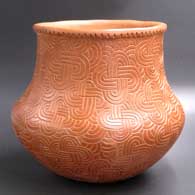Jane Osti
Cherokee

Jane Osti was born in the Rocky Ford area of Tahlequah, Oklahoma. Her father worked as a miner early in her life, later he became a rancher. Her Cherokee mother died when she was 5 years old.
She attended Oaks Mission Elementary School, then Oaks Mission High School in Tahlequah. After graduating Jane got married and started a family. She finally started college when she was 33 and living in San Francisco. In 1985 she moved back to Tahlequah and pursued her formal education in art and education at Oklahoma's Northeastern State University. She was enrolled in Jerry Choate's class, learning to make sculptures and throw pottery on a wheel when a class assignment to interview someone changed everything for her.
The interview was with Cherokee National Treasure and Master Potter Anna Mitchell. It turned into an invitation to learn and help pass on the re-born knowledge of traditional Cherokee pottery with her own love and passion. That soon became a lifelong mentorship.
While Anna taught Jane the traditional basics of processing the clay, coiling and hand building, decorating, then wood firing, she also passed on her heart-felt knowledge and sense of the Cherokee culture, history and tradition embodied in the making of Cherokee pottery.
Three thousand years ago there were potters in the southern Appalachian Mountains making cooking vessels of local clay. In those early days the pots were rough. They got more refined and uniform over time. Then about 1900 years ago the potters began to use paddles to stamp designs on the outer surfaces of their pots. Paddle stamping was their way of getting better heat distribution for cooking and offering a more secure hand grip for carrying and serving. The designs on the paddles added elements of the spiritual to everyday utilitarian objects.
The Cherokee continued developing and refining their pottery tradition until they hit a life-changing roadblock when Congress passed the Indian Removal Act in 1832. The 1830s saw most of the tribe rounded up by the military, relieved of virtually all their property and most of their personal belongings, then forced to negotiate the thousand-mile gauntlet of the Trail of Tears. They were relocated to eastern Oklahoma on land nothing like what they had always known. Many of their ancient traditions fell by the wayside there as everyone's lives became focused on basic survival.
Things went pretty much downhill for them for the next 100 years, then the Bureau of Indian Affairs slowly started to turn around and do the job it was meant to do. Slowly help started coming to the tribes. Most Native American tribes began to revive some of their traditional ways in the 1930s, with ever larger waves of revival coming about every ten years since. The Cherokee were no different for that.
Jane earned her Bachelor of Arts in Art at NSU in 1989, then went on to earn her Master's of Science in Education in 1992. In 1993 she moved to Santa Fe for a while and studied ceramics with John Reeve (of the Barnard Leach school of pottery, London, England). Then she returned to Tahlequah.
Carrying on in Anna Mitchell's footsteps, Jane continues to be both a teacher and a creator of Cherokee pottery. She works with the next generations of Cherokee potters from her studio and gallery in downtown Tahlequah.
Jane's work is based on prehistoric southeastern Woodland- and Mississippian-period themes and forms. Then she blends in her own unique and contemporary spirit.
Jane specializes in coil and slab construction. She also stone polishes and glazes, and wood- or raku-fires.
Jane's design vocabulary is known for sometimes abstract nature, landscape and animal imagery. She also frequently uses protection, endurance and celestial themes in evolving associations. Jane has also created figural vessels such as squashes and gourds. In addition, she has made traditional Cherokee animal effigies, also based on forms found in the ruins of the ancient Mound Builders.
Jane also specializes in creating complex stamped patterns using wooden paddles with intricately carved designs. One of her paddles is covered with a woven burlap fiber, producing a pattern similar to one of the first types of paddles used.
Other Jane Osti signature motifs include rim notching and complex patterns of incised traditional designs intermixed with designs drawn from nature.
Jane Osti was awarded the second Cherokee National Treasure Award for Pottery in 2005. The award recognizes her deep knowledge of Cherokee culture and her continuing efforts to revive, preserve, protect and pass on Cherokee culture and practices that might otherwise be lost to future generations.
Jane's work has been shown in museums across the country and she has earned numerous awards in juried art shows such as the Santa Fe Indian Market, the Red Earth Indian Arts Festival and the Five Civilized Tribes Museum Arts Festival. Her pottery is rich with the earth colors of natural clay and rich with designs and patterns from Cherokee history, life and spirituality.
Some of the above info is drawn from the Indian Craft Shop, Department of the Interior, 1849 C Street NW, Washington, DC 20240. Some is drawn from her bio on Wikipedia and some from old newspaper clippings.
(505) 986-1234 - www.andreafisherpottery.com - All Rights Reserved
